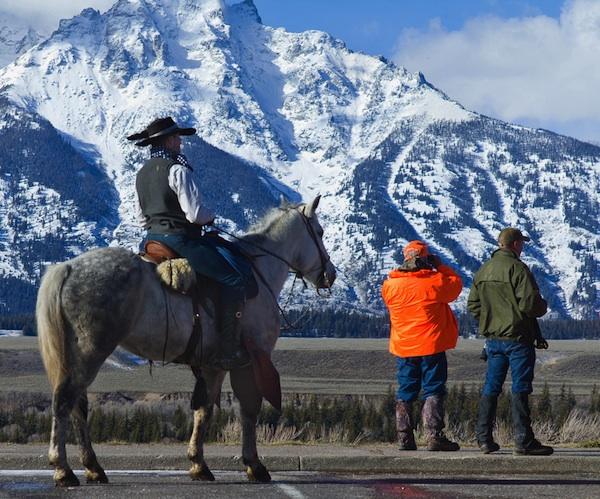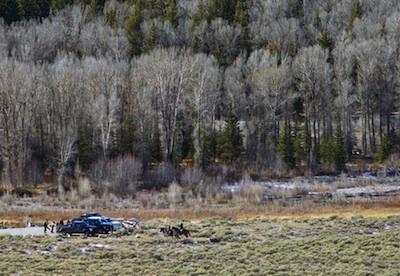
Hunters watch the retrival of the grizzly bear killed in Grand Teton National Park in 2012. As a result of the incident, the park closed about 8 miles of the wooded Snake River bottom lands to hunting in an effort to reduce conflicts/Angus M. Thuermer Jr./WyoFile
Editor's note: The enabling legislation for Grand Teton National Park allowed elk hunting to continue in the park as a means of controlling the elk population, with the understanding that hunters would be "deputized" for the hunt. Over the years, though, problems have cropped up, most recently in 2012 when a grizzly bear was killed by hunters who said they shot in self-defense after the bear charged them. This year's hunt starts tomorrow. In the following story Angus W. Thuermer Jr. reveals that federal wildlife authorities now expect more grizzlies to be killed by hunters than initially thought. This story first appeared in WyoFile earlier this week and is reposted here with permission.
Federal biologists believe elk hunters in Grand Teton National Park and on the National Elk Refuge in the next nine years will kill six more grizzly bears than originally anticipated.
The U.S. Fish and Wildlife Service, the agency overseeing protected species, had said in 2007 it believed hunters would kill only one grizzly in Grand Teton in the following 15 years. It also predicted no grizzly bears would be killed by hunters on the National Elk Refuge through 2022.
That 'incidental take' means the agencies, and the hunts, would not violate the Endangered Species Act as long as the limit of one grizzly was not exceeded. The grizzly is a threatened species protected by the act. An incidental take is not an authorization, but rather the expected harm to a protected species or its habitat ' a likelihood that wildlife managers must take into account when considering federal projects.
But Grand Teton ran up against that one-bear limit in 2012 when hunters killed a grizzly bear on Thanksgiving Day. The 534-pound boar had been feeding on a dead elk and advanced on a party of three hunters, all of who had bear spray.
That shooting caused Grand Teton Superintendent Mary Gibson Scott to 'consult' with the U.S. Fish and Wildlife Service in 2013, and led to a Fish and Wildlife re-assessment of the potential killings by hunters.
'This leaves the park with no additional grizzly bear take related to the (Elk Reduction Program) during the remaining 9 years of the plan's intended 15-year lifespan,' Scott wrote Fish and Wildlife in April, 2013. She also outlined new conservation measures, including the closure of 8 miles of wooded area along the Snake River to hunting.
Reassessment Of Predicted Grizzly Losses
That, and other information, led Fish and Wildlife to increase the number of grizzlies it anticipates would be killed by 2022. The time frame corresponds to the life of the 2007 Bison and Elk Management Plan that examined hunting on the two reserves, among other issues.
WyoFile obtained documents outlining the changes from park hunt critics Tim Mayo and Kent Nelson of Teton County, who organized as Wyoming Wildlife Advocates. They got them from federal agencies through the Freedom of Information Act.
In revising what it expects will result from the hunts, Fish and Wildlife also said the deaths wouldn't harm the Yellowstone ecosystem grizzly population as a whole.
'Given the existing and new conservation measures, we believe the (Bison and Elk Management Plan) plan and the (Grand Teton Elk Reduction Program) will not affect the recovery of the grizzly bears in the ecosystem or result in jeopardy to the species.'
Hunts in the park and on the refuge will result in a 'relatively high risk of hunter-grizzly bear contacts,' Fish and Wildlife said. The statement is from a 2013 Biological Opinion Addendum, the official document sent in response to Superintendent Scott's April letter of that year.

Grand Teton Ranger Ira Blitzblau talks with a hunter at Teton Point Overlook after other hunters shot a grizzly bear during the annual park elk hunt in 2012/Angus M. Thuermer Jr./WyoFile
The biological addendum includes an 'Incidental Take Statement' that lists the expected number of grizzly bear deaths.
Now, Fish and Wildlife expects hunters will kill four more bears in Grand Teton by 2022. Counting the one already killed, the expectation would bring the total of killings in the park hunt to five during the 15-year life of the 2007 Bison and Elk Management Plan.
Changing circumstances, including a growing grizzly population and their expanding range, led Fish and Wildlife to also anticipate grizzlies would be killed on the National Elk Refuge by 2022. In 2007, it made no such predictions.
In its most recent 2013 reassessment, Fish and Wildlife also corrected an error in its 2007 predictions, removing the Bridger-Teton National Forest from its analysis. In 2007, the endangered species watchdog agency said it anticipated two grizzlies to be killed by hunters on the forest. Now, the Bridger-Teton is not included in the incidental take statement.
Federal officials were not immediately available to explain why hunting on the Bridger-Teton is no longer covered. However, provisions of the Endangered Species Act involved with incidental take center on actions by federal agencies. Hunting on the forest is a Wyoming Game and Fish undertaking.
Prediction: Seven Dead Grizzlies By 2022
All told, in 2007 Fish and Wildlife envisioned one grizzly would be lost in 15 years in the park, none on the refuge and two on the forest. Now, the agency anticipates that by 2022 hunters will have killed five bears in Grand Teton and two on the refuge.
'Up to 4 additional grizzly bears in the Park and 2 grizzly bears on the Refuge may be incidentally taken directly or indirectly as a result of the Plan during the remaining 9 years,' Fish and Wildlife said.
The change amounts to a sevenfold increase on the two reserves over the 15-year period. The number of grizzlies anticipated to be lost ecosystem-wide through incidental take has little bearing on the overall grizzly population, officials have said.
Ecosystem mortality limits are set by the Interagency Grizzly Bear Committee, which reported 29 grizzlies lost in 2013, down from 56 in 2012. Anticipated incidental takes are difficult to quantify on an annual basis because assessments are done for various projects across different timeframes, Wildlife Service biologist Ann Belleman said.
The annual incidental take in the ecosystem may amount to eight or 10 bears, Belleman said. That figure is relatively meaningless because population health is figured on an overall mortality count, reproductive trends and other factors, the biologist said.
The count of two bears Fish and Wildlife predicted to be killed in the national forest are no longer part of the incidental take statement. But that doesn't mean the agency doesn't think the deaths won't occur, only that Bridger-Teton hunting is not, and should not have been, part of its purview.

Horsemen retrieve the carcass of the grizzly that was killed on Thanksgiving Day, 2012, in Grand Teton National Park during the annual elk hunt. After that incident, the U.S. Fish and Wildlife increased the number of grizzlies it anticipates will be killed during the park hunt, boosting the estimate through 2022 from one to five/Angus M. Thuermer Jr./WyoFile
Fish and Wildlife took into account Superintendent Scott's hunting ban along the Snake River between Ditch Creek and Deadman's Bar in writing its 2013 biological addendum. Other conservation measures Grand Teton has undertaken include starting the hunt two weeks later, limiting hunters to seven bullets, and prohibiting them from shooting more than once at a group of running elk.
Fish and Wildlife biologists reviewed those restrictions, along with existing rules and the ecosystem grizzly population and trends. Grand Teton had already required hunters to carry bear spray, gave them copious bear-warning material, provided campsites with secure game and food storage, prohibited the use of elk calls, and turned rangers out across the hunt area.
Fish and Wildlife will require the park to submit an annual report of the park hunt, a new condition. The refuge, where hunting for youth license holders began Saturday, will again give out free bear pepper spray this year. It will be available on a first-come, first-served basis in a cooperative program with the Greater Yellowstone Coalition.
With regard to the ecosystem population, Fish and Wildlife said the grizzly count stood at 593 in 2011 and was increasing or stable. It also said grizzlies were wandering farther.
'As anticipated in the (Elk and Bison Management Plan) grizzly bear distribution and numbers in the south end of the Park appear to have increased,' Fish and Wildlife said. 'Since 2007 several grizzly bears have been observed seeking out gut piles left on the landscape during the (elk reduction program) on Park lands and just recently on Refuge lands. It is likely grizzly bears will continue this behavior, resulting in a relatively high risk of hunter-grizzly bear contacts as long as the (Grand Teton Elk Reduction Program) is necessary.'
Grand Teton's senior wildlife biologist Steve Cain has said the hunt will be needed as long as elk are fed in winter on the adjacent National Elk Refuge.
Congress allowed hunting in the park when it expanded Grand Teton in 1950. U.S. Codes allow a 'controlled and managed (elk) reduction by qualified and experienced hunters licensed by the State of Wyoming and deputized as rangers by the Secretary of the Interior.'
Park officials have repeatedly defended the elk reduction program as both legal and required. It is operated in conjunction with Wyoming Game and Fish Department.
In addition to seeking federal documents, Mayo applied to Game and Fish for a park hunt license and secured one for this season. Hunting begins Saturday.
Securing a license is part of Mayo's protest. He recently wrote new Grand Teton Superintendent David Vela a letter titled 'Do not deputize me as a park ranger!' In it he wrote; 'You neglected to vet me in any manner and now you have deputized me so I may roam the park with a loaded high powered rifle.'
Angus M. Thuermer Jr. is the natural resources reporter for WyoFile. He began working at the Jackson Hole News in 1978, and was editor of the Jackson Hole News and Jackson Hole News&Guide before joining WyoFile. Contact him at [email protected] or (307) 690-5586.

 Support Essential Coverage of Essential Places
Support Essential Coverage of Essential Places







Comments
I am not a bear hunter but know that Grizzlies are bold, powerful and smart. Could some of this he solved if the hunters just relinquished their downed elk to the grizz or would that just make the problem worse by educating the grizzlies?
Is the Park looking for a fair chase recreational hunting experence or a biological management tool?
The elk hunt is in the charter of Grand Teton National Park so it can never be lawfully stopped.
The elk hunt is in the charter of Grand Teton National Park and can never be lawfully stopped.